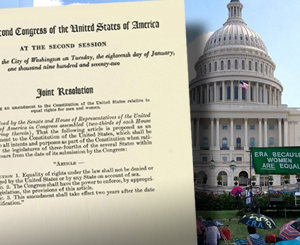Equal Rights Amendment

The results of the Nov. 5 state election in Virginia means control of both the House of Delegates and the Senate will shift in 2020. This has raised the prospect that next year Virginia could become the critical 38th state to ratify the Equal Rights Amendment, which has languished since Congress’ deadline for ratification expired in 1982.
The amendment would add the guarantee of equality of the sexes into the U.S. Constitution. “It is now highly likely that…if we eliminate the (ratification) deadline, Virginia will ratify and become the 38th state, and then the ERA can go into effect as a constitutional amendment,” House Judiciary Committee Chairman Jerrold Nadler, D-N.Y., predicted. Despite Nadler’s optimism, constitutional and legal challenges loom, including the validity of some previous state ratifications.
Since the first 10 amendments, known as the Bill of Rights, were added to the Constitution in 1791, the sacred document has been amended only 17 times. More than two centuries since then, approximately 11,770 measures have been introduced in Congress to amend the Constitution.
The Founding Fathers extensively debated the process to change the U.S. Constitution, before making it difficult to do so. Under Article V, both chambers of Congress would need to approve any amendment by two-thirds vote and three-quarters of the states would have to ratify any specific addition. The president has no stated role.
As detailed in a 2018 Congressional Research Service report, a constitutional amendment guaranteeing equal rights for women was first introduced in Congress in 1923 — three years after ratification of the 19th Amendment giving women the right to vote. But at the time, that proposal failed to achieve either House or Senate approval.
Decades later, as the women’s rights movement gained momentum, Congress passed the ERA in 1972, sending it to the states for ratification. Its text declares that “equality of rights under the law shall not be denied or abridged by the United States or any State on account of sex.” The initial resolution included a seven-year ratification deadline in its preamble, which by then was customary for amendments. In 1978, Congress extended the time limit for ratification to 1982. By the time the second deadline passed, only 35 of the 38 needed states had ratified it.
In the ensuing years, state legislatures in both Nevada (2017) and Illinois (2018) ratified the amendment, bringing the total number of states to 37 or, in theory, one short of ratification. But prior to the 1982 deadline, the legislatures of five states rescinded their earlier ratifications. In 1981, a federal district court judge upheld Idaho’s right to rescind its prior action. A year later, the U.S. Supreme Court declined to review the ruling, declaring the case moot because the ratification deadline had passed.
The prospect that Virginia next year could become the necessary 38th state to ratify the ERA has re-opened debate. On Nov. 13, the House Judiciary Committee approved a resolution eliminating any ERA deadline. While H.J. Resolution 79 is expected to pass the House, its fate in the Republican-controlled Senate is more uncertain.
Over the years, the U.S. Supreme Court has offered limited guidance on how to interpret Article V, and has never addressed the rescission question posed by the Idaho case.
In 1921 in Dillion v. Gloss, the court ruled that Congress could impose a time limit for ratification of seven years, adding Article V “implies that amendments … must be ratified, if at all, within some reasonable time after their proposal.” But in upholding the time frame for the 18th amendment, which created Prohibition, the court did not define “reasonable.”
In Coleman v. Miller in 1939, the court kicked to Congress the decision whether Kansas can approve an amendment years after rejecting it. The ruling said that under Article V this was a political question and solely the authority of Congress to decide.
Interestingly, the last addition to the Constitution — the 27th Amendment, which banned Congress from raising its own salary during a current term — was ratified two centuries after it was first approved by Congress in 1789. But it included no time limit.
If Virginia or another state soon becomes the 38th to ratify the ERA, the legal issues could revolve around the validity of the most recent deadline, whether all prior ratifications remain in effect and are valid and how to treat the five rescissions by state legislatures.
And if a legal challenge is made, scrutiny will turn to the 143 words of Article V and how and which governmental branch — Congress or the courts — should interpret them.
Posted 11/22/2019Other Fact-Checked Subjects:
- Hate Speech
- Flag Burning
- Pardons
- Affirmative Action
- Free Speech
- Ninth Circuit
- Forced Evacuation
- Executive Orders
- National Anthem Controversy
- Gun Laws
- Broadcast Licenses
- Revoking Visas
- Non-Citizen Terrorist Cases
- Religious Displays
- Congressional Seating
- Sexual Harassment
- Revoking Citizenship
- Influencing U.S. Elections
- Legal View of Treason
- Chain Migration
- Guns and Courts
- Students' Right to Protest
- Attorney-Client Privilege
- Recusal
- The President and the Law
- Immigrant Rights
- Revoking Security Clearances
- Confidentiality Agreements
- Resigned or Fired
- Deadly Force
- Birthright Citizenship
- Press Credentials
- Troops at the Border
- Election Re-Vote
- Emergency Powers
- Immigration Law
- Contempt of Congress
- Boycotting 2020 Census
- Electoral College
- Impeachment
- Separation of Powers
- Equal Rights Amendment
- Whistleblower Protection
- Pandemic Authority
- State Powers
- Employer Limits
- Police Immunity
- Federal Forces
- Hatch Act
- Attorney General Authority
- Frivolous Lawsuits
- Social Media and the First Amendment
- D.C. Statehood
- Executive Privilege
- Russian Sanctions
- Law of Genocide
- Stare Decisis
- Declassified




